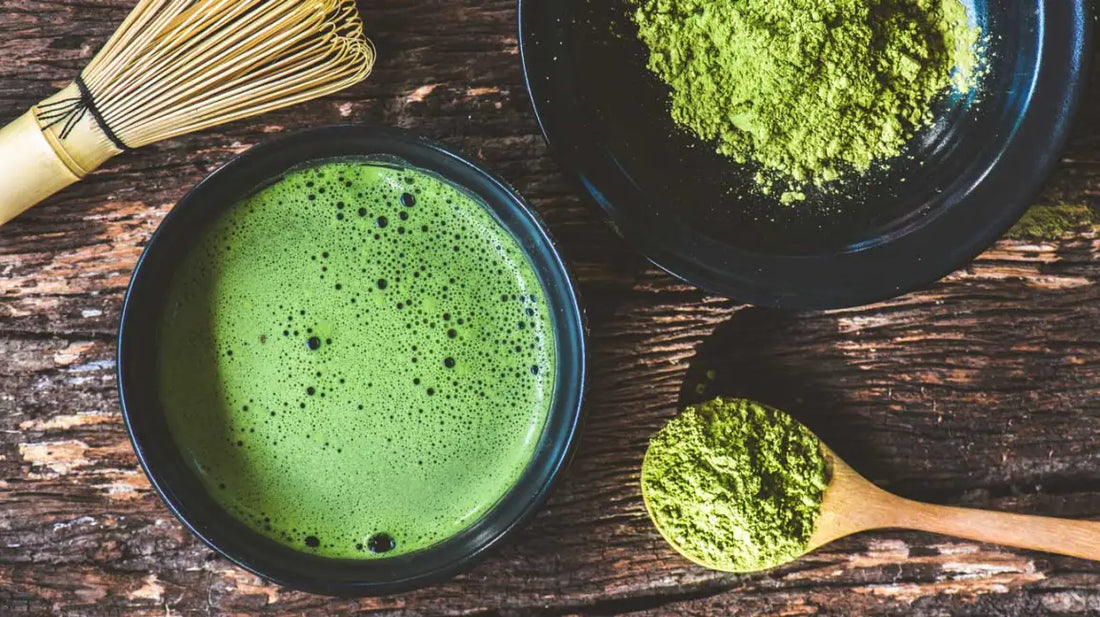
Ceremonial Matcha vs Culinary Matcha
Share
Ceremonial Matcha vs Culinary Matcha: Understanding the Differences
Have you ever wondered about the difference between ceremonial matcha and culinary matcha? Although matcha has grown greatly in popularity over the last 10 years, it has a rich history that goes back over 1,000 years. Japanese tea farmers developed matcha, a finely ground green tea powder derived from whole leaves, cherished for its health-promoting properties.
Zen monks used matcha to enhance concentration during extended meditation sessions, while Samurai warriors consumed it to achieve heightened mental acuity and lucidity before combat. Today, countless individuals worldwide continue to appreciate matcha for its delightful taste, as well as its beneficial impact on emotional well-being, vitality, and overall health.
Quick Facts About Ceremonial Grade Matcha
-
Ceremonial matcha contains over 137 times more antioxidants than regular green tea.
-
It promotes a state of "calm focus" due to its high l-theanine levels.
-
It contains catechins that aid in nutrient absorption, microbiome health, and have cancer-fighting properties.
-
Studies suggest that matcha and green tea have anti-viral properties that may offer protection in settings with high rates of viral respiratory infections.
-
It is a top source of EGCG, which supports cognitive health and reduces inflammation.
Ceremonial Matcha vs Culinary Matcha
Matcha, a finely ground powder made from specially grown and processed green tea leaves, has been used in traditional Japanese tea ceremonies for centuries. However, in recent years, matcha has gained popularity in the Western world for its health benefits, unique flavor, and versatility in the kitchen.
If you’re new to matcha, you may have noticed two different types available: ceremonial grade and culinary grade. But what exactly is the difference? And which one should you choose for your needs? Let’s explore the key differences between ceremonial and culinary matcha to help you make an informed decision.
What is Ceremonial Matcha?
Ceremonial matcha is made from the highest quality tea leaves, usually the youngest and most tender leaves of the tea plant. These leaves are carefully grown, harvested, and processed to produce a fine, vibrant green powder with a delicate flavor and smooth texture.
Ceremonial matcha is traditionally used in Japanese tea ceremonies, where it is prepared with hot water and enjoyed as a simple, yet elegant, drink. This type of matcha has a subtle sweetness, a slightly vegetal taste, and a smooth finish.
Did you know that even within ceremonial grade matcha, there can be variations in quality? Some growers use the practice of “honzu,” shading the leaves in the weeks before harvesting to enhance quality, color, and nutrition.
What is Culinary Matcha?
Culinary matcha, on the other hand, is made from older, more mature tea leaves that are less expensive and easier to cultivate. The processing of culinary matcha is less meticulous than that of ceremonial grade, resulting in a coarser powder with a darker green color.
As the name suggests, culinary matcha is primarily used for cooking and baking rather than drinking as a standalone tea. It has a stronger, more bitter flavor, making it ideal for recipes like lattes, smoothies, cakes, and pastries.
Key Differences Between Ceremonial Matcha and Culinary Matcha
-
Quality and Flavor: Ceremonial grade matcha is made from higher-quality leaves, resulting in a smoother texture and delicate flavor, while culinary grade matcha has a stronger, more bitter taste.
-
Nutritional Value: Ceremonial grade matcha has higher antioxidant levels than culinary grade due to how early it’s picked.
-
Color and Texture: Ceremonial matcha has a vibrant green color and fine texture, whereas culinary matcha has a darker green color and coarser texture.
-
Usage: Ceremonial matcha is ideal for drinking as a traditional tea, while culinary matcha is best used in recipes that incorporate additional ingredients.
-
Price: Due to the higher quality leaves and meticulous processing, ceremonial matcha is typically more expensive than culinary matcha.
Which Matcha Grade Should You Choose?
The choice between ceremonial and culinary matcha depends on how you plan to use it. If you want to experience matcha in its traditional form, ceremonial grade is the best option. However, if you’re incorporating matcha into recipes like smoothies, baked goods, or lattes, culinary grade matcha will work well and be more cost-effective.
While ceremonial grade matcha may be pricier, its superior quality and delicate flavor make it a worthy investment for those who enjoy matcha as a tea. On the other hand, culinary matcha provides many of the health benefits of matcha at a lower price, making it perfect for everyday use in recipes.
Looking for the Best Matcha?
Our matcha is produced in Uji City near Kyoto, Japan, the birthplace of matcha tea traditions. This region is known for producing some of Japan’s finest matcha, recognized for its bright color and rich flavor.
We use the "shade-grown" technique—meaning our matcha plants are shaded for 20 days before harvest. This process enhances the bright emerald green color due to increased chlorophyll production, boosts antioxidant levels, and increases amino acids like l-theanine, which is responsible for matcha’s signature "calm focus."
Additionally, we test our matcha for bacteria, yeast, mold, and over 500 pesticides and heavy metals. Our matcha even meets California’s rigorous heavy metal standards. Grown without pesticides, our matcha is verified to have potent concentrations of antioxidants, l-theanine, and theobromine.
Whether you're looking for the highest quality ceremonial matcha for traditional tea preparation or a high-quality culinary matcha for delicious recipes, our matcha delivers the best in both taste and nutrition.

